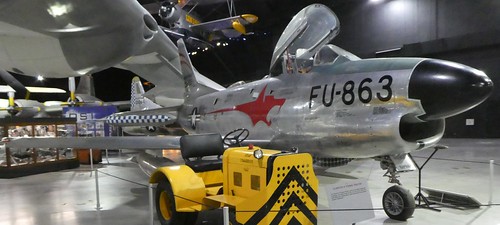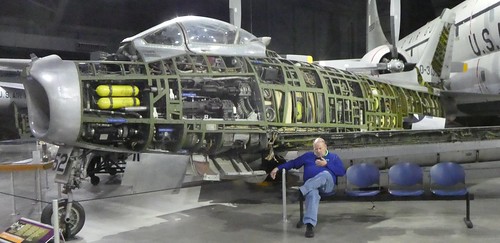The National Museum of the United States Air Force in Dayton, Ohio has several Sabrejets on display.
North American F-86A Sabre
According to the Museum:
The F-86, the U.S. Air Force's first swept-wing jet fighter, made its initial flight in October 1947. The first production model flew in May 1948, and four months later, an F-86A set a new world speed record of 670.9 mph.
As a day fighter, the F-86A (and later F-86Es and F-86Fs) saw service in Korea as the primary opponent of the Russian-built MiG-15. By the end of hostilities, F-86 pilots had shot down 792 MiGs, with a kill ratio of about 8:1.
More than 5,500 F-86 day fighters were built in the U.S. and Canada. Air forces of 20 other nations, including West Germany, Japan, Spain, Great Britain and Australia, also operated the Sabre.
This plane has a maximum speed of 685 mph, a range of 1,200 miles, and a ceiling of 49,000 feet.



North American F-86D Sabre
According to the Museum:
An intelligence warning in 1948 prompted the U.S. Air Force to hurriedly develop an all-weather interceptor. Starting with the basic airframe of its F-86A, North American incorporated two unprecedented concepts into the F-86D (initially designated the F-95). First, a highly sophisticated electronic system replaced the second crewmember carried by other interceptors of the time. Second, the F-86D became the first production single-seat fighter to which air-to-air missiles replaced the classic gun armament.
With its air intake reshaped to make room for the enclosed radar, the F-86D -- nicknamed "Sabre Dog" -- presented a distinctive profile. The interception radar (from Hughes Aircraft Co.) and associated fire-control computed the target's position, guided the aircraft on an intercept course to within 500 yards of the target, lowered the retractable tray of 24 rockets, and fired the rockets automatically. The effect of these weapons would have been devastating to an enemy bomber because each 2.75-inch Mighty Mouse folding fin aircraft rocket (FFAR) contained the power of a 75mm artillery shell. The first prototype (YF-86D) flew on Dec. 22, 1949, and North American delivered 2,506 F-86Ds before production ended in September 1953. Although the U.S. Air Force had phased out its F-86D by June 1961, Japan and other nations continued flying them.
This aircraft has a top speed of 761 mph, a range of 800 miles, and a ceiling of 50,000 feet.




North American F-86H Sabre
According to the Museum:
The F-86H, perfected after the signing of the Korean Armistice, represented the practical application of knowledge gained from the thousands of combat missions flown by the earlier F-86A, E and F variants. Primarily a fighter-bomber, the F-86H was larger and heavier than its predecessors, but it had better all-around performance.
The airplane was produced from late 1953 to August 1955, North American produced more than 450 F-86Hs. Although never used in combat, it provided the U.S. Air Force with a formidable fighter-bomber aircraft until the advent of the supersonic F-100.
This aircraft has a top speed of 693 mph, and a range of 1,050 miles.





North American F-86H Sabre








North American F-100D Super Sabre
According to the Museum:
Developed as a follow-on to the F-86 Sabre used in the Korean War, the F-100 was the world's first production airplane capable of flying faster than the speed of sound in level flight (760 mph). The prototype -- the YF-100A -- made its first flight on May 25, 1953, at Edwards Air Force Base, Calif. Of the 2,294 F-100s built before production ended in 1959, 1,274 were Ds, more than all the other series combined. The D model, which made its first flight on Jan. 24, 1956, was the most advanced production version. Its features included the first autopilot designed for a supersonic jet and a low-altitude bombing system. The Super Sabre had its combat debut in Vietnam where it was used extensively as a fighter-bomber in ground-support missions such as attacking bridges, road junctions and troop concentrations.
This aircraft has a top speed of 927 mph, a cruising speed of 590 mph, a range of 1,970 miles, and a ceiling of 55.000 feet.



North American F-100F Super Sabre
According to the Museum:
After the single-seat, supersonic F-100 fighter entered service in 1954, it developed a high accident rate, in part due to pilot inexperience with the Super Sabre. In response North American built a two-seat training version -- the F-100F -- to train new Super Sabre pilots.
The F-100F retained the basic combat capabilities of the F-100D, including six wing hardpoints to carry external stores, but reduced the number of 20mm cannon from four to two. North American delivered the last of 339 F-100Fs in 1959.
When F-100 units deployed to Southeast Asia, they included a mix of one- and two-seat F-100s, and both types participated in traditional bombing missions in support of ground forces. As tactics developed, the two-seat F-100F became an important aircraft for two new missions -- surface to air missile (SAM) suppression, known as "Iron Hand," and high-speed forward air control (FAC), known as "Misty FAC."
This aircraft has a top speed of 875 mph and a range of 1,661 miles.




More fighter jet displays
Air Force Museum: MiGs (photo diary)
Museum of Flight: Jet fighters of the 1950s (photo diary)
Museum of Flight: Jet fighters of the 1960s (photo diary)
Planes of Fame: Some Jet Fighters (Photo Diary)
Evergreen Aviation: Some Jet Fighters (photo diary)
Evergreen Aviation: Jet Planes (photo diary)


